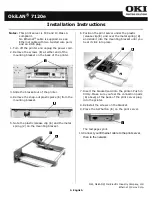
Intel®
Server System SR1625UR TPS
Cooling Subsystem
Revision 1.5
Intel order number E47487-007
27
The individual system fans are not hot-swappable and require the system to be turned off
before being replaced. The chassis is classified as a “Service Access Only” device and caution
should be exercised when replacing a system fan, as they do not have finger guards. However,
provisions are built into the fan bracket to prevent accidental contact with the fan rotors. Each
fan within the module is capable of supporting multiple speeds. If the internal ambient
temperature of the system exceeds the value programmed into the thermal sensor data record
(SDR), the Integrated BMC firmware increases the speed for all the fans within the fan module.
Each fan connector within the module supplies two tachometer signals (one for each fan rotor)
allowing the Integrated Baseboard Management Controller to monitor the status of each fan
rotor. If a fan fails, the remaining fans increase their rotation and attempt to maintain the
thermal requirements of the system.
Each system fan has an associated fan fault LED located next to its fan cable connector on the
midplane board. The fan fault LED is controlled by the Integrated BMC. If a fan rotor within a
system fan fails, it illuminates the fan fault LED and logs the failure into the System Event Log.
Table 20. Fan Connector Pin Assingment
Pin
Signal Name
Description
1
Tachometer B
Fan RPM sensor output
2
PWM
Fan speed control signal
3
12 V
Power for fan
4
12 V
Power for fan
5
Tachometer A
Fan RPM sensor output
6
Return
Return path to ground
7
Return
Return path to ground
8
Fan Presence
Detection if fan is installed in system
9
LED Cathode
Loopback signal to pin 10
10
LED Anode
Loopback signal to pin 9
The system fan cables plug into the connectors on the midplane board as shown in the
following figure. Both passive and active midplanes have the same fan numbering and fan
connector locations.
















































